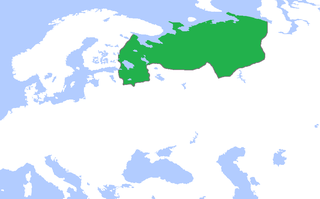Kolo Volost (Russian : волость Коло) was a territorial division (a volost ) of the Novgorod Republic.

Russian is an East Slavic language, which is official in the Russian Federation, Belarus, Kazakhstan and Kyrgyzstan, as well as being widely used throughout Eastern Europe, the Baltic states, the Caucasus and Central Asia. It was the de facto language of the Soviet Union until its dissolution on 25 December 1991. Although nearly three decades have passed since the breakup of the Soviet Union, Russian is used in official capacity or in public life in all the post-Soviet nation-states, as well as in Israel and Mongolia.
Volost was a traditional administrative subdivision in Eastern Europe.

The Novgorod Republic or Novgorodian Rus' was a medieval East Slavic state from the 12th to 15th centuries, stretching from the Baltic Sea to the northern Ural Mountains, including the city of Novgorod and the Lake Ladoga regions of modern Russia. Citizens referred to their city-state as "His Majesty Lord Novgorod the Great", or more often as "Lord Novgorod the Great". The Republic prospered as the easternmost port of the Hanseatic League and its Slavic, Baltic and Finnic people were much influenced by the culture of the Viking-Varangians and Byzantine people.
It was first mentioned in the 13th century. [1] The last documentary mention of the volost was in the 15th century. [1]
Kolo Volost bordered Tre Volost approximately along the line between Kildin Island and Turiy Headland of the Turiy Peninsula. [1] Kolo Volost was situated to the west of that line, while Tre Volost laid to the west of it. [1]
Tre Volost was a territorial division of the Novgorod Republic.

Kildin is a small Russian island in the Barents Sea, off the Russian shore and about 120 km from Norway. Administratively, Kildin belongs to the Murmansk Oblast of the Russian Federation.
A headland is a coastal landform, a point of land usually high and often with a sheer drop, that extends into a body of water. It is a type of promontory. A headland of considerable size often is called a cape. Headlands are characterised by high, breaking waves, rocky shores, intense erosion, and steep sea cliffs.


